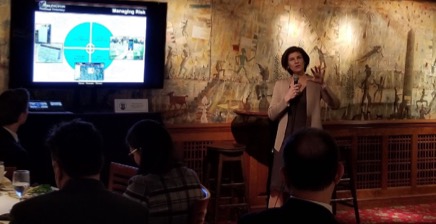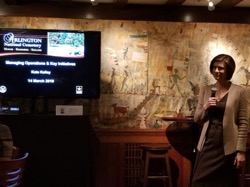On March 14, 2019, the Association of Federal Enterprise Risk Management (AFERM) hosted an event featuring a discussion with Katharine (Kate) Kelley, the Superintendent of the Arlington National Cemetery.
Ms. Kelley discussed how transparency and the establishment of a more risk aware culture has helped restore public trust with both the cemetery and the Army. In addition, she discussed how delivery of the cemetery’s important mission is dependent on accountability, transparency, and relationship building.
Creating a Risk Aware Culture
Ms. Kelley spoke about the challenges that faced Arlington Cemetery when she became Superintendent in January of 2016. She talked about how human resources management, land availability, data accuracy, and public visibility all factor into the cemetery’s risk equation. The risk culture needed to be changed from a siloed approach, to a more open and honest communication approach where her 180+ civilian staff could raise issues and concerns without fear of repercussions. Ms. Kelley mentioned past negative news stories and how it became imperative to identify risks and issues before they manifested into serious situations.
The environment at the Arlington Cemetery has changed to where now, all are encouraged to identify and raise issues, concerns, and risks. She brought up an occasion where a person noticed construction occurring in potentially the wrong place. Instead of not saying anything because it was with a different department, the person raised the issue horizontally to the right department and helped avert a crisis. She also stated that in order to make good judgement calls, it is critical to have the right people on the job who can think critically and are passionate about the mission.
 Restoring Public Trust
Restoring Public Trust
Arlington National Cemetery represents the American people by laying to rest those who have served our nation with honor while engaging 4+ million guests each year in the cemetery’s living history. Ms. Kelley talked about the rich history as-well-as the national visibility of the cemetery and how when she arrived, there was a renewed responsibility for public transparency and outreach. She mentioned that until recently, the cemetery used 3×5 index cards to identify burial markers, which date from 1864. There was a pressing need for an accurate and reliable data system in addition to records chains of custody. Accurate data along with public outreach, which included a website with individual photos of each marker, helped restore public trust in both the cemetery and the Army.
Relationship Building
 Ms. Kelley discussed a point of pride with her and her staff which is the relationships that have been built over the past few years. She mentioned the relationships with Congress and the American people through an open and honest dialog. She talked about how this will be important going forward as there are constant risks with burials, land constraints, and opening and moving grave sites. She was instrumental in putting an advisory process in place where there is open and honest communication and feedback.
Ms. Kelley discussed a point of pride with her and her staff which is the relationships that have been built over the past few years. She mentioned the relationships with Congress and the American people through an open and honest dialog. She talked about how this will be important going forward as there are constant risks with burials, land constraints, and opening and moving grave sites. She was instrumental in putting an advisory process in place where there is open and honest communication and feedback.


